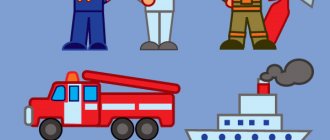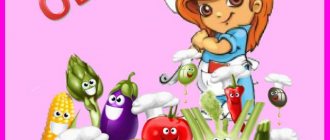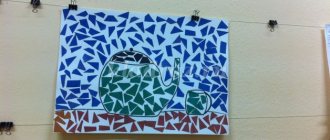Wild and domestic animals, as well as their young
This provides an excellent opportunity to look at the animals up close and almost touch them. This is a good time to learn the names of baby animals. Children often call a piglet a pig and a foal a horse. And especially for those who have speech problems, it is difficult to remember who is whose mother, father, son. It is possible to practice lexical material using a visual example, for example: “cat - cat - kitten - kittens” or “bull - cow - calf - calves”.
Learn to use correctly: “one pig - two pigs - five pigs.” And also the lamb is from a sheep, and its father is a ram. The hen has the chick, and the father is the rooster. It would be nice to photograph all these domestic animals, and then, looking at the photographs, remember. Look for them in pictures, coloring books, choosing the right colors (the chicken is yellow and the goose is white). At the same time, vocabulary is consolidated, grammatical structure, sensory and fine motor skills are developed.
Meaning of the word vegetable garden
- O. is a plot of land, mostly enclosed by a fence or hedge and intended for growing vegetables and other garden plants (see Vegetables and Gardening). O. are usually located near or in the estate itself.
Choosing a location. The most diverse places, both in relief and in soil, are allocated for O., however, every effort is made for their best adaptation: high places are surrounded by a rampart planted with a hedge (best of all with spruce, always covered with pine needles and at the same time not giving strong shadow), low ones - drain. Such artificial measures are all the more necessary because some plants like shade, others like bright light, some like moist soil, others like drier soil, etc.
Soil improvement. In the same way, they adapt the soil: clayey, too viscous soil is loosened by adding sand or heavily fertilizing it; light, sandy soil is mixed with clay (in autumn or winter) to add viscosity and with peat (in the spring before fertilizing) to enrich it with humus. Acidic humus soils and those poor in lime are improved by adding calcareous or marl soil. All these changes are made, again guided by the needs of the plants.
protection is necessary, especially from the north and east, as well as from blowing winds. Grell considers the best protection to be two rows of fir trees, located slightly away from the fence.
Separation of vegetables - Plants are divided into several sections, based on the idea that for the best growth of vegetables, like other plants, it is necessary to use fruit rotation. The simplest method is to divide the soil into four parts (according to Rytov - into three), of which the first is used to grow plants that require fresh fertilizer, for example, cabbage, and the soil is pre-cultivated for the pass (see Vegetable gardening); Cucumbers are sown on the second part, potatoes or root vegetables on the third, and legumes on the fourth. The next year, the plants move, with cabbage taking the place of legumes, legumes taking the place of potatoes, etc. In other cases (according to Schroeder), the garden is divided into two equal areas: annual plants are cultivated on one, and perennials on the other. In this case, every year there is a partial transition of 1/4 or 1/5 of the area of annuals to an equal area of perennials, so that after 8-10 years there will be a large turnover or a complete change of place between annuals and perennials. In addition to this rotation, the annual crop, divided into its 4 fields, has its own rotation, since some of the plants are sown with fresh fertilizer, others a year after it. In addition to areas included in the fruiting season, a special place is allocated in O. for biennial seed plants (with thin soil), for early forcing of vegetables (with rich soil), for nurseries (beds with good soil, adapted for covering them with mats of straw), and for ridges (beds in protected places, near walls, fences, hedges, etc., intended for growing delicate or ornamental plants, as well as for shrubs and fruit trees that provide shade). Then, in specially selected places with clay subsoil, greenhouses are built, as well as planters, i.e., reservoirs for collecting rain and snow water; to reduce water evaporation, they are lined with trees. In the shaded corners of the garden, places are allocated for compost heaps.
E. Karatygin.
Connection with other words
Words containing -garden-:
- Mother of God
- nonresident
- out-of-town
- out-of-town
- Bogorodoe
- Bogorodsk
Words starting with garden-:
- vegetable garden
- gardener
- horticulture
- vegetable garden
- garden
Hypo-hyperonymic relationships
garden plot
What is a vegetable garden like (adjectives)?
Selection of adjectives for words based on the Russian language.
small stranger large well-groomed small broken own whole abandoned apothecary vast huge neglected neighbor neighboring former cultivated village quiet monastery new collective farm general good prominent secret tiny dear best beautiful personal private empty large cabbage first medicinal herbal desert arranged abandoned spacious school overgrown individual stunted surrounding Soviet divorced nearest real naked stunning endless peasant brown egg mushroom necessary tiny full favorite plowed floating
What can a vegetable garden do? What can you do with your garden (verbs)?
Selection of verbs for words based on the Russian language.
spread overgrow appear have stand stretch grow swarm get out work be turn dig grow stick out come out steal give engage stretch flicker imagine dig up get in the habit of climb begin seem to go down let fill up run turn green please tighten up settle down occupy fly carry deliver adjoin help out pile up provide shift keep grow up dig around plant dig go climb stay visible end plow break exist alternate break out demand resist shine
Associations to the word vegetable garden
house kitchen forest bed vegetable cabbage potato fence search village bathhouse limit window ditch dacha shovel river greenhouse roof backyard garden outskirts grass yard city wall weed lake glade field side hour order shore castle aunt direction pond growing house neighborhood back landing pretext scarecrow outskirts road bathhouse museum tree pumpkin greens river Sheila village greenhouse accounting scaring away bunch hose church transformation root Petersburg
Synonyms for vegetable garden
skit
Hypernyms for vegetable garden
- plantation plot
Scope of use of the word vegetable garden
General vocabulary Proverb Agriculture Idiomatic expression Ecology
On the topic: methodological developments, presentations and notes
Presentation on the lexical topic “Vegetable garden. Garden". Expansion and activation of the dictionary on the topic.
The script is designed to secure vegetables and fruits. Where they sprout.
Summary of a lesson used in conjunction with a multimedia power point program with Bunny animation and playback of the inserted sound.
Homework for parents.
Homework on the lexical topic “Garden.Vegetables” (information corner).
From September 30 to September 4, we studied with children the lexical topic “Vegetable garden. Vegetables". Here, parents can find material to reinforce with their children at home the knowledge and skills acquired in kindergarten.
Source of the article: https://nsportal.ru/detskiy-sad/razvitie-rechi/2019/03/13/leksicheskiy-material-sad-ogorod
Summary of a lesson on speech development in the preparatory group on the topic “Vegetables. Garden"
Lyubov Zolotukhina
Summary of a lesson on speech development in the preparatory group on the topic “Vegetables. Garden"
Summary of a lesson in the preparatory group on the topic “ Vegetables . Vegetable garden »
Compiling a descriptive story “Tomato”
by pictures-symbols.
formation of nouns with diminutive suffixes;
mastering verbs with different meanings;
selection of relative adjectives to nouns;
the use in speech of sentences with the meaning of opposition;
Corrective and developmental tasks:
develop and activate vocabulary on the topic “ Vegetables ”
;
develop mental activity, attention;
instill in children an interest in the environment;
develop proper nutrition skills;
Equipment: pictures-symbols; didactic game “Let's help Lisa the goat”; pictures of vegetables .
Progress of the lesson:
Children sit on chairs.
Educator: Guys, look where we have ended up. What do you think it is? ( Vegetable Garden )
There are 2 beds on the floor, on one of them there are vegetables.
- What grows in our garden ?
- Look who came to visit us? (dog toy is included)
Let's come up with a name for our dog. (children take turns suggesting dog names)
- Ball.
- Let's say hello to Sharik. Children take turns greeting Sharik.
- Look carefully at Sharik and describe him.
-Let's pet our Sharik. What does it feel like?
Why do you think the ball is sitting in our garden ?
We plant the ball near the garden bed.
— What vegetables do you see in our garden?
Children's individual responses. (I see)
Guys, I have a magic basket. What do you think is in it? (A basket of vegetables is brought out)
.
Game "Find the same"
“Here, let’s plant some vegetables in our empty garden bed.”
Children take turns taking a vegetable from the basket, name it, describe its appearance, and examine what the vegetable feels like. Vegetables are laid out in the same way as in the first bed.
Tools
It will also be interesting for your child to learn about tools. Explain that there are working tools (saw, hammer, axe) and gardening tools (shovel, rake), what they are used for, and what they do with them. If you are making a birdhouse (bench, gate), you need to saw off the boards and drive in nails. We dig the beds with a shovel, level them with a rake, and remove debris from the site. You can buy children's instruments for children so that they can use them to the best of their ability to do something, to take part in a common cause.
Water from a watering can, collect garbage, hammer nails into a board next to dad. It would be appropriate to talk about compliance with safety precautions. And then let the kid tell you what you need to do so as not to hit your finger with a hammer and how to position the rake correctly so that it doesn’t hit anyone with its handle. Why you can’t walk on dug-up beds, and how to hold a watering can correctly so that water doesn’t spill in vain.
Insects and small animals
As it gets warmer, more insects and other small animals appear. This is also a very fertile topic for enriching vocabulary and developing grammatical structure. Children, if they are not afraid, love to collect all kinds of small animals: worms, frogs, grasshoppers, beetles, snails. They make houses for them and put them in jars. Pay attention to the method of movement - some animals fly, others crawl, others jump and gallop.
Butterflies fly OVER the flower and land ON them, or maybe even on the palm. But it is better not to touch them, as they have very delicate wings. Bees fly and collect honey, and can also sting. Grasshoppers jump from grass to grass. And earthworms hide UNDER the boards. Snails can crawl on walls and leaves. The ladybug crawls along the palm, reaches the highest finger and flies away. While she is moving, you can say: “Ladybug, fly to the sky, your children are eating candy there.”
After the end of the summer season, we return home and remember how we spent the summer, what we did. And at this time, outside the window, autumn rain is pouring or a winter snowstorm is blowing. And we look at photographs, drawings and crafts, eat pickles and preserves, drink tea and make plans for next summer. To consolidate, you can play in a store (selling fruits and vegetables, tools), a barnyard and a zoo, an insect house.
This is where I finish writing this article, but there will be a continuation about outdoor games, trips to the forest, what to do in bad weather and on the beach near the water in good weather. And also how to organize a birthday party at the dacha. Follow the updates, subscribe to the news. Write in the comments about your impressions of outdoor recreation, the country house and the garden. Share with friends and relatives on social networks.
Development of lexico-grammatical structure
Let's touch on several lexical topics that can be practiced in this situation:
- signs of spring
- tools: gardening, working
- migratory, wintering and domestic birds
- plants
- vegetables fruits
- wild and domestic animals
- insects and other small animals
The dictionary is activated, translated from passive to active.
At the same time, it is necessary to practice the correct use in constructing sentences and phrases:
- case endings of nouns
- agreement with adjectives in gender, number and case
- signs of an object
- subject actions
- the position of objects in space relative to each other (to the left, above, far)
And the ability to build a dialogue, conduct a conversation:
- remember what happened
- tell me what you are doing now
- tell us what you are going to do in the future
correctly arguing and justifying your actions.
Plants
In addition to animals, we pay attention to plants. Firstly, based on their size, the trees are large and tall, the shrubs (bushes) are shorter, and the grass and flowers are very short and thin. But at the same time, they also have common characteristics: leaves, stems, roots and flowers. You can compare deciduous and coniferous trees (evergreens) - “Winter and summer are the same color. What is this?". “In the spring it turns green, but in the fall it turns yellow?”, remember riddles about trees and plants
Then you can move on to comparing cultivated and wild (wild and domestic) plants. Here we remember garden flowers (tulips, daffodils) and wildflowers (daisies, buttercups), compare trees that grow in the forest and in the garden (fruit trees). Please note that the apple tree can be wild, wild and that its fruits are small and sour. Wild plants grow on their own, but cultivated plants need to be looked after. And here you can not only tell the child, but also show him what to do in the garden.







